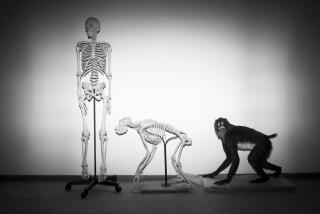DNA from Neanderthal toe reveals interbreeding among ancient species
- Share via
A 50,000-year-old toe bone found in a Siberian cave is giving scientists a surprising view of the breeding habits of early humans.
In what has been described as a “Lord of the Rings”-type world, researchers say that Homo sapiens, Neanderthals and two other groups of early humans mingled and interbred thousands of years before all species but ours became extinct.
The findings were presented Wednesday in the journal Nature by a team of scientists who sequenced the DNA from the Neanderthal toe fossil and compared it to the genomes of 25 present-day humans, as well as the genome of a sister group to Neanderthals called Denisovans.
FOR THE RECORD:
Neanderthal DNA: An article in the Dec. 19 Section A about the discovery of a fossilized Neanderthal toe bone said that 2% of Neanderthal DNA was present in modern people not of African descent. It should have said that 2% of the DNA of these humans came from Neanderthals. In addition, the article said that 0.5% of Neanderthal DNA was contributed to an extinct group called Denisovans, and that Denisovans contributed 0.2% of their DNA to Asian and Native American people. It should have said that 0.5% of Denisovan DNA came from Neanderthals, and that an estimated 0.2% of the DNA of mainland Asians and Native Americans comes from Denisovans.
According to their analysis, Neanderthals contributed roughly 2% of their DNA to modern people outside Africa and half a percent to Denisovans, who contributed 0.2% of their DNA to Asian and Native American people.
The biggest surprise, though, was the finding that a fourth hominin contributed roughly 6% of the DNA in the Denisovan genome. The identity of this DNA donor remains a mystery.
“It is possible that this unknown hominin was what is known from the fossil record as Homo erectus,” said lead study author Kay Prufer, a geneticist at the Max Planck Institute for Evolutionary Anthropology in Leipzig, Germany. “Further studies are necessary to support or reject this possibility.”
Geneticists and anthropologists said the inch-long bone and resulting analysis have greatly illuminated a period of time roughly 12,000 to 126,000 years ago.
“It does seem that Eurasia during the Late Pleistocene was an interesting place to be a hominin, with individuals of at least four quite diverged groups living, meeting and occasionally having sex,” biologist Ewan Birney of the European Bioinformatics Institute and Stanford geneticist Jonathan Pritchard wrote in a commentary that accompanied the study.
The toe bone was discovered in an ancient natural shelter called Denisova Cave, in Siberia’s Altai Mountains. It was in the same cave that archaeologists discovered evidence of the Denisovans, who were recognized as a distinct group in 2010.
Based on DNA taken from the toe bone, researchers were able to determine that it belonged to a female Neanderthal. They could also tell that her parents were very closely related, and “were either half siblings who had a mother in common, double first cousins, an uncle and a niece, an aunt and a nephew, a grandfather and a granddaughter, or a grandmother and a grandson,” they wrote in the study.
Such inbreeding might have been necessary because the Neanderthal population was very small, perhaps already well on the road toward extinction, the study authors suggested.
“The data are consistent with the population being small enough that breeding among relatives was reasonably common,” said UC Berkeley biologist Montgomery Slatkin, a member of the research team. DNA analysis of additional Neanderthal remains would be needed to confirm that hunch, Slatkin said.
The study authors estimated that the ancestors of Neanderthals and Denisovans split from the lineage that led to modern humans roughly 600,000 years ago, and then split between each other roughly 400,000 years ago.
Based on the genomes of each group, researchers concluded that all of their populations were in decline at least 1 million years ago. Sometime after that, our ancestors began to grow in number while the Neanderthal and Denisovan populations continued to shrink. Researchers estimate that Homo sapiens became the planet’s sole surviving humans roughly 30,000 years ago.
While the study’s conclusions were sure to fire the imagination of the general public, at least one outside expert said the anthropological sleuthing had just begun.
John Hawks, a paleoanthropologist at the University of Wisconsin, Madison, said it was very difficult to pin down the timing and number of groups involved in genetic mixing.
“We could really be looking at mixture from multiple different populations with different histories,” Hawks said.
Study authors hope that by mapping the Neanderthal genome they might gain insights into the evolution of modern humans. The list of DNA sequences that distinguish us from Neanderthals is relatively short, according to the study’s senior author, Svante Paabo, director of the Max Planck Institute’s department of genetics.
“It’s a catalog of the genetic features that sets all modern humans apart from all other organisms living or extinct,” Paabo wrote in a statement released by the institute. “I believe that in it hide some of the things that made the enormous expansion of human populations and human culture and technology in the last 100,000 years possible.”
ALSO:
Neanderthals put time and effort into burying their dead, study finds
Ancient DNA from early human creates new mystery
Neanderthals organized their caves around tasks, study says







